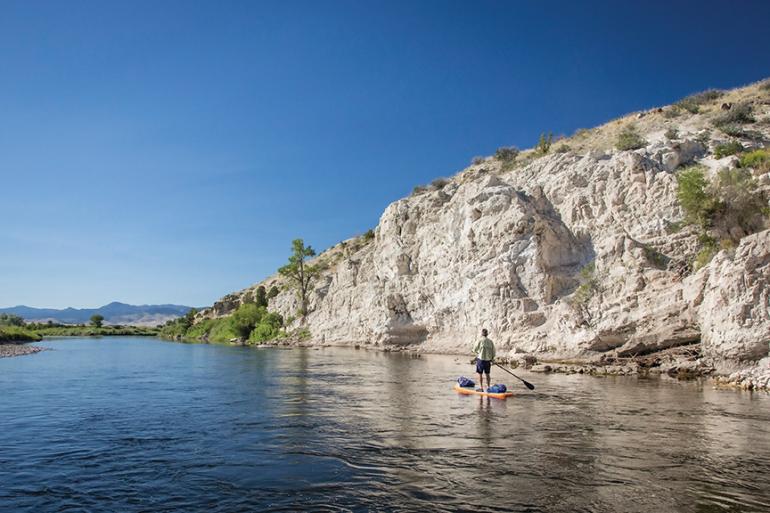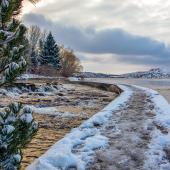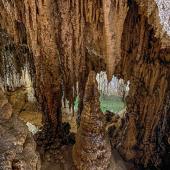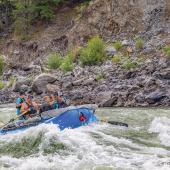The Forgotten Fork
Two days on the Jefferson River.
“Watch out for rattlesnakes,” a middle-aged blonde warns as we strap our dry bags onto our paddleboards at the Silver Star boat launch, 11 miles north of Twin Bridges. “They’re on land and in the river.” Despite my deep-seated fear of serpents, the thought of a swimming rattlesnake is intriguing. My friend Aaron and I check our bags one final time, ask the woman to snap a quick photo, and slip into the current, eyes wide for rattlers.
This is the Jefferson, just east of the Continental Divide. The river is shallow and slow, freeing us to fret about snakes and our plan to paddleboard 60 river-miles in just two days. But as the launch recedes behind us, so too does my worrying. Golden-green summer grass stretches across the valley and up the flanks of the Tobacco Roots to the east. Dark green forests drape the highlands, crowned by jagged rocky peaks. A cloudless sky, so perfectly blue it seems like a movie set, presides over the scene. For a couple of paddlers accustomed to western Montana’s tighter, more forested river valleys, the views seem almost too expansive. In the foreground, dense thickets of willow and bright green stands of cottonwood dot the floodplain.
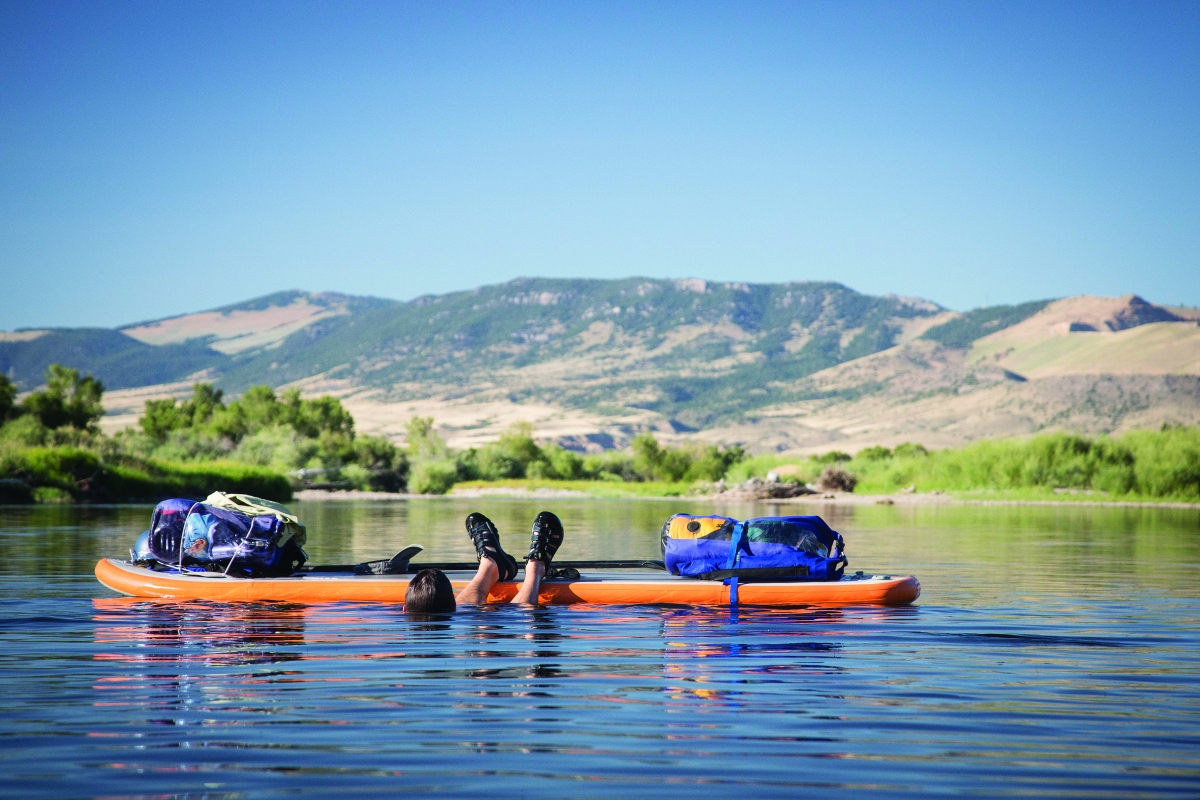
The Jefferson is something of a contradiction as far as rivers go. It hosted iconic Western explorers like Lewis and Clark, but history buffs celebrate the Missouri more often than not. It can provide spectacular multi-day trips, but sees mostly day use. It offers decent fishing—especially for big brown trout that like the slow-moving water—but it’s also polluted by heavy metals from past mining activities and chronically dewatered from agricultural withdrawals. It’s part of the Lewis and Clark National Historic Trail, but is overshadowed by the more famous Madison and Gallatin rivers, closer to Bozeman.
We find a rhythm and a couple of hours drift by. It seems that every bird species in Montana is here—cedar waxwings, western tanagers, bald eagles, a harrier hawk, kingbirds, herons, goldfinches, and mergansers. We round a bend to watch 40 white pelicans rise from a cobble bar in the middle of the river.
Despite its second-class reputation, the Jefferson is becoming better-known and more popular, thanks in large part to Tom Elpel. Elpel, a resident of nearby Pony and the founder of the Jefferson River Canoe Trail, has dedicated much of the last two decades to encouraging appreciation and recreational use of the Jefferson. “We want people to know what an amazing place this is,” he says. “If we can build demand for the Jefferson, more people will know about it and then care about it.”
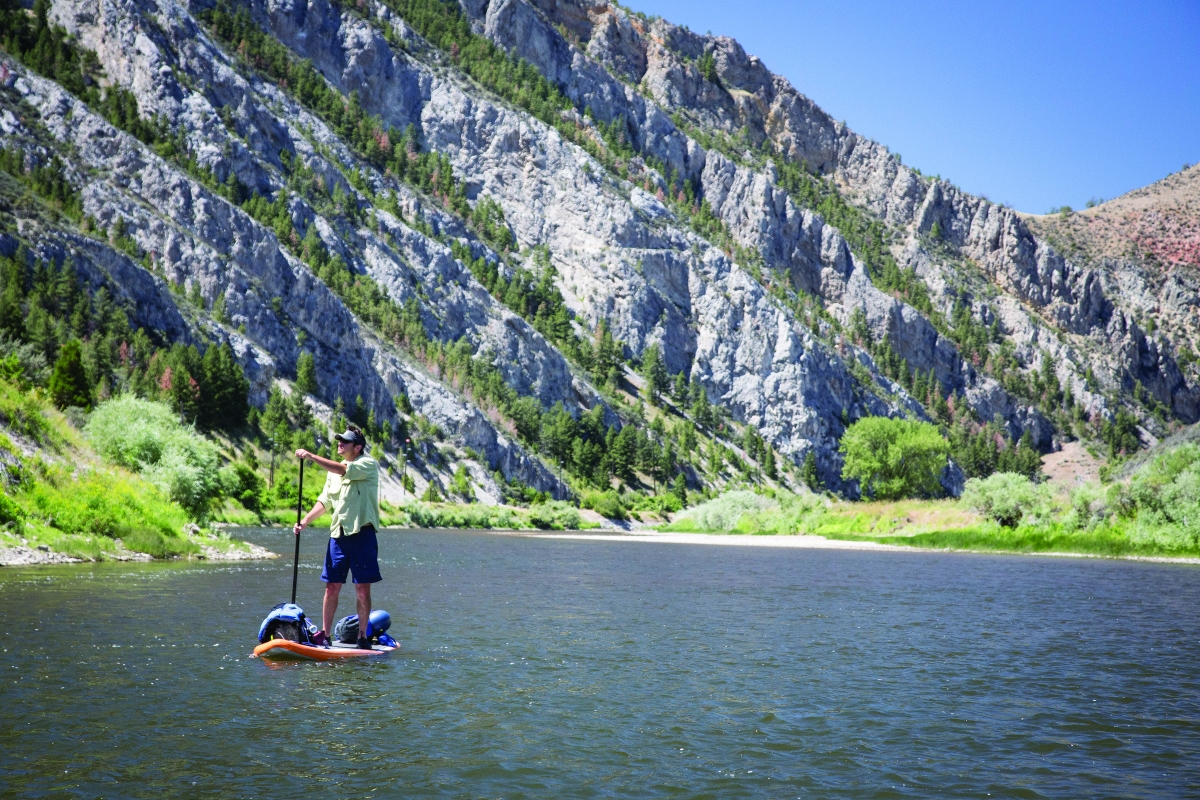
His main concern for the river isn’t heavy metals or water temperature, but development. His group aims to secure land for campsites, and encourage conservation of the river corridor—specifically limiting the development of houses right along the river’s banks. Developing more campsites is an important component to managing increased recreational use on the Jefferson. Much of the land along the river is privately owned, but there is a smattering of camping options on BLM and Forest Service land. Last fall, Elpel’s group bought a few acres of riverfront for a new campsite and day-use area near the confluence of the Jefferson and the Madison. A few more purchases like that and the Jefferson will boast some of the best and easiest multi-day paddling in the state.
Late in the day, Aaron and I take advantage of the access that does exist, and find a perfect camping spot on a long thin island about 30 miles from where we started. We stretch our sore backs and pitch our tents in the fading light while sandhill cranes call to each other across the river. Their otherworldly staccato rises and falls as we bask in the sprawling views and soft evening sunlight.
My thoughts drift to the Corps of Discovery. I wonder how much of this river they’d recognize today, 209 years after they camped along its banks. A whirring movement breaks my reverie. The nighthawks are out. As they dart through the gathering darkness, wings humming like jet engines, we collect driftwood for a fire and recall the wildlife we’d seen that day: a mink porpoising through the water, a beaver heading up a small side-channel, a moose standing in the thick willows, foxes darting through the cottonwoods, almost two dozen bird species—but not a single aquatic rattlesnake. We share some whiskey as stars prick the inky sky and our fire burns to embers.
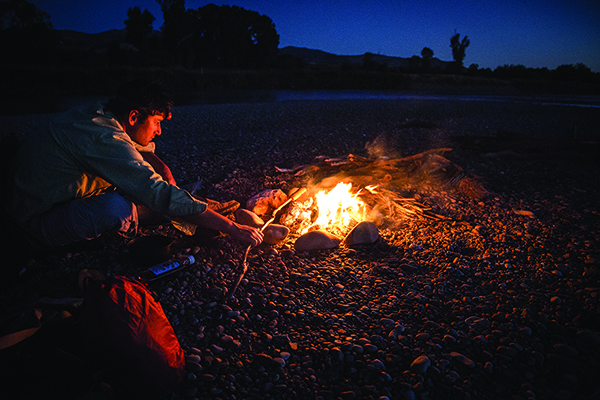
The next day dawns clear and bright. We relax as the sun warms the cobbles and dries the last of the dew from our gear. Soon, we’re strapping our dry bags to the boards and paddling back into the current. As we make our way downstream, the mountains recede into the distance and the river shows more signs of development.
Fenceposts strung together with barbed wire dangle from steep, eroded banks. A thick coat of algae covers the cobbles. Around one bend, we surprise a handful of hogs in a pen that stretches all the way to the river, and they run squealing from the riverbank. More and more houses appear, with bright green lawns providing stark contrast to the golden hills that stretch beyond.
By lunch, we’ve entered the river’s canyon. Steep, purple-gray cliffs rise from both sides of the river, their northern flanks draped in dark conifers. We pass the parking lot for Lewis & Clark Caverns and debate whether we want to hike the three miles to see them. We opt to stay on the river.
Paddleboarding on a river is a bit like riding a magic carpet—we stand there and watch as the river pulls us along. With about 15 miles still to go, Aaron and I alternate between paddling hard and just drifting along, saving our arms and shoulders from getting too sore. The final miles seem to last forever, like the final miles of any long trip. Part of me is excited to get to the car, sit down, and relax. Part of me wants to keep going—paddle down the Missouri, then the Mississippi to St. Louis, tracing the Corps of Discovery’s route in reverse. But the bridge that marks our take-out soon comes into view.
I paddle to the bank and step off of my board, but promise to return. I want to check out the new campsite Elpel’s group purchased, explore the 25 miles of river we didn’t paddle, and find the secret hot springs I’d read about. Mostly though, I want to see a rattlesnake swim across the mighty Jefferson in the fading light of a long day on another spectacular Montana river.

